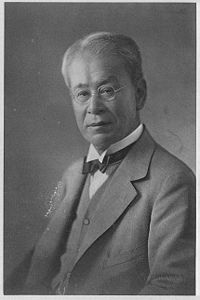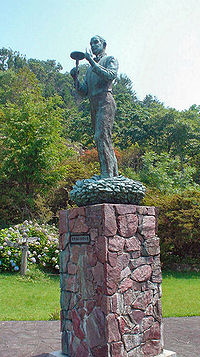
Tomitaro Makino
Encyclopedia

Carolus Linnaeus
Carl Linnaeus , also known after his ennoblement as , was a Swedish botanist, physician, and zoologist, who laid the foundations for the modern scheme of binomial nomenclature. He is known as the father of modern taxonomy, and is also considered one of the fathers of modern ecology...
. His research resulted in documenting 50,000 specimens, many of which are represented in his Makino's Illustrated Flora of Japan. Despite having dropped out of grammar school
Grammar school
A grammar school is one of several different types of school in the history of education in the United Kingdom and some other English-speaking countries, originally a school teaching classical languages but more recently an academically-oriented secondary school.The original purpose of mediaeval...
, he would eventually attain a Doctor of Science
Doctor of Science
Doctor of Science , usually abbreviated Sc.D., D.Sc., S.D. or Dr.Sc., is an academic research degree awarded in a number of countries throughout the world. In some countries Doctor of Science is the name used for the standard doctorate in the sciences, elsewhere the Sc.D...
degree, and his birthday is remembered as Botany Day in Japan.

Biography
Tomitaro Makino was born in SakawaSakawa, Kochi
is a town located in Takaoka District, Kōchi, Japan. It is 28km west of Kōchi City.As of February 29, 2008, Sakawa has an estimated population of 14,606 and a population density of 144.03 persons per km². The total area is 101.21 km².-Geography:...
, Kōchi
Kochi Prefecture
is a prefecture of Japan located on the south coast of Shikoku. The capital is the city of Kōchi.- History :Prior to the Meiji Restoration, Kōchi was known as Tosa Province and was controlled by the Chosokabe clan in the Sengoku period and the Yamauchi family during the Edo period.- Geography...
to a prestigious sake brewer. His parents died during his early childhood, and he was raised mainly by his grandmother. Though he dropped out of school after two years, he cultivated a strong interest in English, geography, and especially in botany. In 1880, he became a teacher at the primary school
Primary education
A primary school is an institution in which children receive the first stage of compulsory education known as primary or elementary education. Primary school is the preferred term in the United Kingdom and many Commonwealth Nations, and in most publications of the United Nations Educational,...
in his hometown, where he published his first academic botanical paper.
In 1884, he moved to Tokyo
Tokyo
, ; officially , is one of the 47 prefectures of Japan. Tokyo is the capital of Japan, the center of the Greater Tokyo Area, and the largest metropolitan area of Japan. It is the seat of the Japanese government and the Imperial Palace, and the home of the Japanese Imperial Family...
to pursue his botanical interests at the University of Tokyo
University of Tokyo
, abbreviated as , is a major research university located in Tokyo, Japan. The University has 10 faculties with a total of around 30,000 students, 2,100 of whom are foreign. Its five campuses are in Hongō, Komaba, Kashiwa, Shirokane and Nakano. It is considered to be the most prestigious university...
. He was granted access to their research facilities by Professor Ryokichi Yatabe, and started to publish an academic journal
Academic journal
An academic journal is a peer-reviewed periodical in which scholarship relating to a particular academic discipline is published. Academic journals serve as forums for the introduction and presentation for scrutiny of new research, and the critique of existing research...
of botany in 1887. He married in 1890 and would later have 13 children.
In 1936, he published Makino Book of Botany, a six volume text on botany, in which he describes 6000 species, 1000 of which he discovered.
He is best known for his Makino's Illustrated Flora of Japan, published 1940, which is still used as an encyclopedic text today.
In 1948, he was invited to the Imperial Palace
Kokyo
is the main residence of the Emperor of Japan. It is a large park-like area located in the Chiyoda area of Tokyo close to Tokyo Station and contains several buildings including the main palace , the emperor left Kyoto Imperial Palace for Tokyo...
to lecture on botany for Emperor Hirohito.
After his death in 1957, his collection of approximately 400,000 specimens was donated to Tokyo Metropolitan University
Tokyo Metropolitan University
Tokyo Metropolitan University is one of the largest public universities in Japan...
. The Makino Herbarium in Tokyo
Tokyo
, ; officially , is one of the 47 prefectures of Japan. Tokyo is the capital of Japan, the center of the Greater Tokyo Area, and the largest metropolitan area of Japan. It is the seat of the Japanese government and the Imperial Palace, and the home of the Japanese Imperial Family...
and the Makino Botanical Garden
Makino Botanical Garden
The , also known as the Kochi Prefectural Makino Botanical Garden, is a botanical garden located at Godaisan 4200-6, Kōchi, Kōchi Prefecture, Japan. It is open to the public daily except Mondays; an admission fee is charged....
on Mount Godai in his native Kōchi
Kochi Prefecture
is a prefecture of Japan located on the south coast of Shikoku. The capital is the city of Kōchi.- History :Prior to the Meiji Restoration, Kōchi was known as Tosa Province and was controlled by the Chosokabe clan in the Sengoku period and the Yamauchi family during the Edo period.- Geography...
were named in his honor. He was also named an Honorary Citizen
Citizenship
Citizenship is the state of being a citizen of a particular social, political, national, or human resource community. Citizenship status, under social contract theory, carries with it both rights and responsibilities...
of Tokyo.
Taxonomic work
In total, Makino named over 2500 plants, including 1000 new speciesSpecies
In biology, a species is one of the basic units of biological classification and a taxonomic rank. A species is often defined as a group of organisms capable of interbreeding and producing fertile offspring. While in many cases this definition is adequate, more precise or differing measures are...
and 1500 new varieties
Variety (biology)
In botanical nomenclature, variety is a taxonomic rank below that of species: as such, it gets a three-part infraspecific name....
. In addition, he discovered about 600 new species.
Selected publications
- Makino shokubutsugaku zenshū (Makino's Book of Botany) Sōsakuin, 1936
- Makino shin Nihon shokubutsu zukan (Makino's New Illustrated Flora of Japan), Hokuryūkan, 1989, ISBN 4-8326-0010-9

